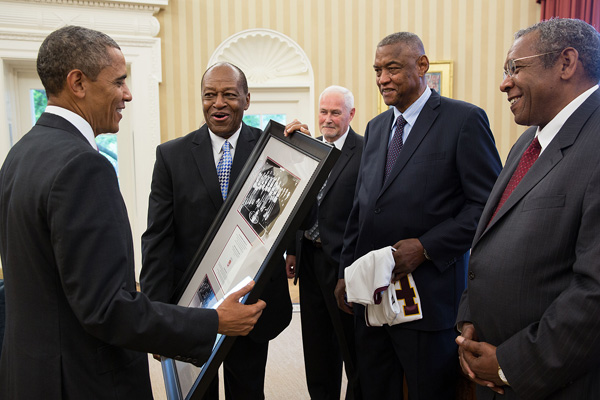
Photo: Pete Souza/The White House
Last week, in a quietly underplayed meeting at the White House, the president welcomed the 1963 Loyola Ramblers basketball team—still, astonishingly, the only Illinois school ever to have won a NCAA Division I championship in basketball—to celebrate the 50th anniversary of their underdog victory over then-powerhouse Cincinnati, which had won two straight NCAA championships out of four straight Final Four appearances. It was Loyola's first appearance in the tournament.
But it's more than a Chicagoan president honoring one exception to a surprisingly bleak history of state collegiate basketball. The 1963 Ramblers aren't as famous as the 1966 Texas Western team with five black starters, another upstart team that knocked off a legendary program, the Kentucky Wildcats. And the team the Ramblers beat in the finals had won the year before with four black starters. But it's still an important team in the history of American sports and race relations. The day before what would become known as the "Game of Change," the Ramblers didn't know who they'd be playing in the third round of the NCAA tournament:
Last night, Loyola university was not sure who it will face in the Mideast regional of the National Collegiate Athletic Association basketball tournament tomorrow night in East Lansing, Mich.
Loyola was scheduled to play Mississippi State, champion of the Southeastern conference. But late yesterday afternoon, Chancery Judge L.B. Porter signed a temporary order prohibiting use of state funds for Mississippi State to play in the meet because it is racially integrated.
[snip]
The injunction forbids spending the state money for mixed athletic activities outside the state and from breaching what it termed the public policy against integrated athletics. [Chicago Tribune, 3/14/1963]
Previously, MSU had skipped three NCAA tournaments to avoid playing integrated teams. But the president, a graduate of progressive Berea College, and the athletic director skipped the state in advance of physically receiving the injunction. They made it to Michigan in time to get beat by #3 Loyola, which beat #8 Illinois, #2 Duke, and finally #1 Cincinnati, 60-58 in overtime.
But the Ramblers, as a Chicago team, had to deal with race in their own way—if not on the court, then off it. My former boss at the Reader, Michael Lenehan, recently published a book on the team: Ramblers: Loyola-Chicago 1963—the Team that Changed the Color of College Basketball. In it, Jack Egan, the team's sole white starter, a tough guard from Marquette Park, recounts the kind of tensions that cut through the city, and its athletic teams:
"It was such a bigoted time," Egan said. "Obviously the neighborhood was very, very prejudiced. [In 1966, Martin Luther King was one of 30 people injured as he marched through Marquette Park.] See, most of the people who lived in this neighborhood had lived in another neighborhood before that. And it was a movement from east to west, and all these people are escaping. Oh my God, don't let a black move in there, you're gone, you're dead. That's how everybody felt. St. Elizabeth's [an all-black Catholic school] couldn't play at St. Rita [an all-white Catholic school] at night. They could only play on Sunday afternoons. Because guys went up on top of Walgreens, on the corner of 63rd and Western, and threw garbage cans down on the people waiting for buses. I mean I didn't know anybody—none of my friends would do that. They might chase blacks, they might fight with blacks, but taking a garbage can and throwing it down on people waiting for a bus, that's too much. There's kids there and there's mothers—you know, that's a criminal act. But people wouldn't say oh, let's turn them in. That wasn't the thought."
And the integrated Loyola team's victory did not bring them great glory in Chicago, either. As Lenehan points out, the only live broadcast of the game was on the radio. Channel 11 tape-delayed the game in lieu of the Blackhawks; Channel 7 showed the state high-school basketball tournament. Then as now, Chicago was more in thrall to prep hoops than college; the same night, Carver High won the state title, and according to the Trib, 15,000 people welcomed the Carver champs in Altgeld Gardens, while only 2,000 celebrated the Loyola victory. Carver got top billing.
The team's star and first-team All-American, Jerry Harkness, moved between the business and sport worlds, trading brief stints with the Knicks and Pacers with work as a salesman, franchise operator, and basketball commentator for the Pacers. But just after he'd secured the only NCAA championship the state's ever seen, Harkness ran into the color barriers that had not yet fallen in Chicago. He worked as a salesman for Quaker Oats, covering the north side and suburbs around the college he'd brought glory to. But, as Lenehan writes, he and his wife "tried to rent an apartment on the North Side, not far from the campus where Harkness had lived for four years, but were turned away by a landlord who didn't want blacks in the building. They wound up living on the South Side."


